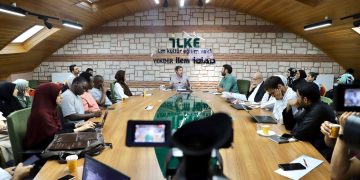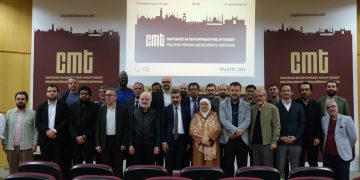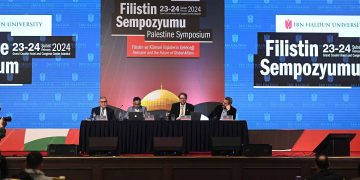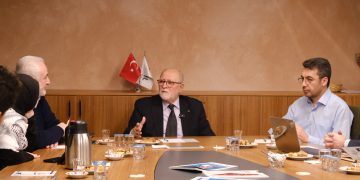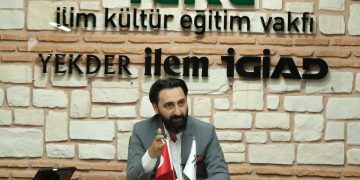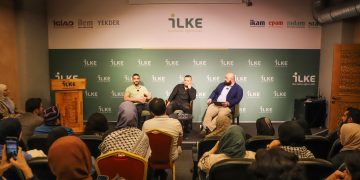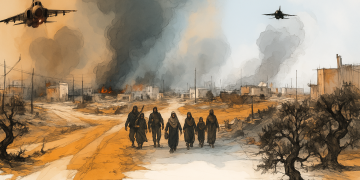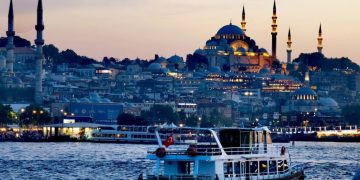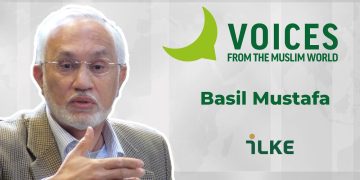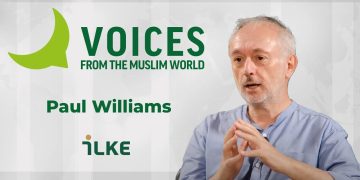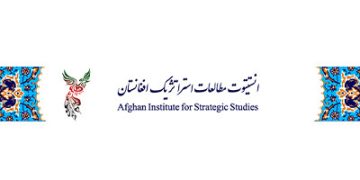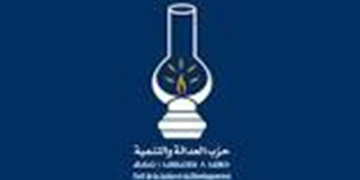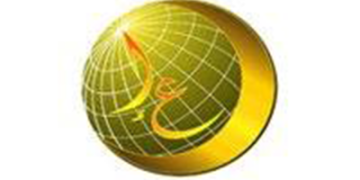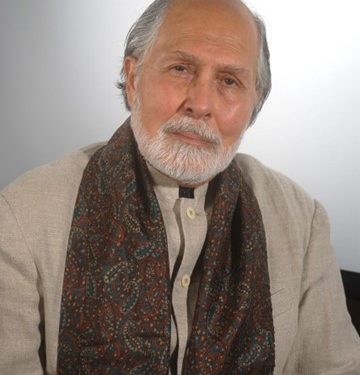Seyyed Hossein Nasr, born in Tehran in 1933 as a member of a family that raised famous scholars whose origins go back to Kashan, grew up in an environment where traditional religious understanding and various aspects of art were permeated. The core of his passion for philosophy, literature, and science began to sprout in such an environment. After completing his primary education in Iran, he completed his undergraduate studies in physics at the Massachusetts Institute of Technology (MIT), his graduate studies in geology and geophysics, and then his doctorate in the history of science at Harvard. While teaching at MIT and Harvard, he decided to return to Iran in 1958. In addition to his lectures at Tehran and Aryamehr universities, he founded the Imperial Iranian Academy of Philosophy. Here he worked with the world’s leading scientists and philosophers. After 1979, he moved to America with his family and continued his work there. One can say that he authored several works and raised many students throughout his prolific life.
Seyyed Hossein Nasr, who has recently been a very influential intellectual with his works, writings, and conferences he gave all over the world, is an important figure in Turkey. He is renowned for his books and efforts to reveal how to fulfil the promise made by Muslims in Bazm-i Alast by putting the idea of tradition at the centre. It is possible to discuss some, if not all, of Nasr’s influences, from tradition to the understanding of being and from art to the history of science, under several headings.
Being and the Cosmic Journey
According to Nasr, beings are on a cosmic journey toward the Source of their being, in other words, to Being and Beyond Being simultaneously. Some people in the world are unaware of the existence of such a journey. Some of them try to position their lives in line with the understanding of the mystery of our situation before we were born into the lower universe, namely the world and the place we will go to. Coming from Source is described as the descending arc, and returning to the Source is described as the ascending arc. As it oscillates between these two arcs, consciousness always comes first.. Remember that knowing who we are, according to Nasr, will play a key role in reaching our human truth by opening the veils of ordinary consciousness. And then our identity, which stands beyond the limit of time and space – one of Nasr’s starting points is that the concept of identity as a sign of our dependence on the Self, the Core, is essentially in His Knowledge and that the only truth, both in the beginning and at the end, is the Truth since we have no other truth than this-.
Consciousness First
The two aspects expressed in Saint Augustine’s statement that ” In man, there are two [natures]” (Duo sunt in homine) raise the question of what should be decisive in the course of man. Seeking the possibility of appearance and going beyond appearance is mandatory to move from phenomenon to noumenon. Having the faculty of imagination, we need to continue our journey in the world by trying to transform the imaginary landscape within us without being stuck in the realm of images. Just as the shell has to be broken in order to reach the core and taste, it is necessary to go beyond the realm of images and turn towards the truth. This is equivalent to a timeless journey to our Source. The journey in question essentially aims at “remembering” the promise we made in the past of being conscious of Whose slaves we are. In other words, we should be in pursuit of realizing that there is an effort to make people forget the promise with countless curtains in the world and remember it as if to nullify the saying that “what is out of sight becomes out of mind.” Lifting the veil of oblivion is also a progression from self-knowledge to Self-knowledge beyond discursive thinking.
The Essence of Knowledge or The Knowledge of The Self
The theomorphic nature of man, or the divine breath inherent in him, makes him a work of the True Artist, and when he reaches a sufficient cognitive capacity, the way is opened for him to grasp his true nature. Man has two choices before him: devotion or rebellion. If he wishes, he finds harmony with the cosmic laws and the realities of the archetypal world and does what he does by devoting himself to the Self. This situation is essentially the manifestation of its essential nature, a realization. As in the saying of Mawlana,
We are like the harp, and You are strumming (upon it). The mournful (sound is) not from us, (but) You are causing the lament.
We are like the reed-flute, and the melody within us is from You. We are like mountains, and the echo within us is from You.
However, suppose he moves away from the Centre and prefers rebellion. In that case, he finds himself in a futile rivalry, which is the source of the demand for a lifestyle that is out of essence and exempt from its original nature in the modern world. Adopting a style identical to the rebellion is the wish of the Promethean or, as Nasr puts it, the rebellious/disobedient man. Since a disobedient man acts based on rebellion in his works, he starts to distance himself from Origin, and as he moves away, he begins to identify himself with what he does. On the other hand, the perfect human being who adopts the attitude of devotion strives to fulfil the requirements of the promise he made in the past eternity, with the desire to return to the centre, his original homeland, from this lower world to which he was descended.
Perfect Human Being
In ancient understanding, man was conceived as a bridge between earth and sky. For this reason, the human being, described as a caliph of Allah on earth, has not lost his understanding of Root/Origin and Centre even though he is in the world. It can be thought of as a reflection of the circle’s centre. He is responsible for his actions and has to be conscious of his primary functions, such as being heir and guardian on earth. If he can do this, he also realizes that his short journey on earth contains levels of meaning where danger and grace, burden, and favour are intertwined. After such a complicated journey, he knows very well that the ship that will carry him to the real world was actually built with what he thought and did in this limited world. On the other hand, following modern understanding, human thought takes the opposite position to God as rebelling against Him and appropriating His role. The rebellious person, who embodies this understanding, feels he belongs to this world. However, the world in the minds appears before us as an artificial world designed by the rebellious man to forget his true nature rather than a reflection of Heaven. Since the sense of the sacred is almost lost in such a world, there can be ample justification for the delusion, even arrogance, that man creates his destiny. Nasr states that even in this case, the possibility of cravings for the Holy and Eternal leads to the pursuit of satisfaction, from psychological novels to mystical quests woven with psychedelic drugs.
On the one hand, the reckless man tries to avoid the effects of the great destruction he has caused on the environment; on the other hand, he is imprisoned in his dungeon as a result of turning away from an environment that will be a cure for his troubles. As if the damage he inflicted on himself was not enough, he participated in irreparable destruction on earth over five centuries. This “creature”, adept at upsetting the ecological balance in the natural order, cannot grasp the meaning of being human. The crisis in question in terms of the environment is a crisis of the natural world and a harbinger of a crisis that occurs within the human being or microcosm.
Environment and Crisis
The environmental crisis, which Seyyed Hossein Nasr deals with in various aspects in his works and speeches, is expressed in a way that goes beyond the famous reflections of this expression. According to Nasr, if a “crisis” is mentioned, it implicitly shows that something is not in place and is dangerous and it is a situation we are aware of. Otherwise, an ordinary situation is not considered a crisis. Undoubtedly, conflicts occurred between man and nature in previous periods as well. Although there have been some effects on the environment since the beginning of agriculture, the balance in ecology is an indication that there is no crisis. The crisis that arises with the destruction of the environment does not arise from real needs but greed and artificial needs. The devastation caused by modern technology has been compounded by the loss of the human sense of compassion. As a result, due to the removal of the “Hand of God” from the equation, it has become impossible to hide behind planting a few saplings here and there or a simple cosmetic change involving limited sanctions. However, the commandment in verse “Whatever is in the heavens and the earth glorifies Allah” exclaims that trying to destroy living species without a legitimate reason is the same as destroying the voices that are busy praising the glorification of God.
How to overcome this crisis is a focus of Seyyed Hossein Nasr. According to Nasr, in our scientific tradition, solutions for this have already been preached.
Modern science and Scientism
The rational and spiritual framework, lacking for a long time, has been discussed in depth in the Islamic intellectual tradition. We have to analyse the current situation first and then make an effort to take a step within the intellectual tradition. In this way, lighting the lamp of an authentic natural philosophy or natural metaphysics understanding will facilitate the reopening of knowledge transmission channels. The fusion of virtue and knowledge can be achieved by reviving appropriate commons with an attitude against scientism rather than science. With the revival of our intellectual tradition, the ideas will become transferable to institutions. So first, an idea is based on tradition, and then it is inherited by institutions like art, education, etc. – just like Guénon and Schuon, Nasr points out that “tradition”, derived from the Latin word tradere, meaning “inheritance”, is composed of theoretical and applied aspects – by this way liveliness and continuation take place. Contrary to this, scientistism, which can be defined as acquiring the world’s knowledge and selling the soul to the devil, with a “Faustian” understanding of science, does everything to destroy the environment in the guise of technology. In order to eliminate this destruction, we need to integrate the commons influenced by the Islamic worldview; in fact, Nasr’s findings about the need to have the seal of tradition in both education and art are quite remarkable.
Traditional art
Seyyed Hossein Nasr emphasizes that the tradition, which remains unchanged even though the times have changed, possesses a nature that transcends words. The message of the tradition has been engraved in the great book of nature and the pages of the holy books and traditional and sacred works of art have also had their share. It should be kept in mind that traditional art is primarily related to sacred knowledge or knowledge of the sacred. This relationship is a channel of knowledge, grace, and sacred knowledge (scientia sacra). In this respect, traditional art is unique in its peaceful, inspirational, and functional aspects. So, the traditional works of art, which we inherit and are a channel of the mysterial and inspirational aspects present in our archetype, or spirit, reflect what is in the archetype. Since Allah has written beauty in all aspects and He loves what is beautiful, it is destined for the beauty in the archetype or creation to leak out after the curtains are lifted, just as whatever is in the jug leaks out. At this point, Nasr states that there is a distinction between traditional art and sacred art, as frequently expressed by other members of the Traditionalist School, of which he is the greatest living representative. According to this distinction, sacred artwork is considered religious because of the subject or function it is related to. On contrary, traditional artwork is considered traditional because of its harmony with the laws of cosmic form, the genius of the spiritual world that affects images in which it is revealed, the nature of the material used, and the truth. Every surrounding where the traditional truth has the opportunity to reflect is the place where the tradition has the opportunity to manifest its art before theology and philosophy. While it is necessary to overcome images and break the shell for the manifestation of art, the importance of the images, which indicates the existence of the core or the essence, should not be overlooked. However, staying in pure form and not being able to go beyond is like a summary of the current situation. It is the key to first reaching a certain level of consciousness regarding the origin of our being, and who we are, similar to a course revealed in Hindus as being (sat), consciousness (fence), and happiness (ananda). In short, the journey made in the direction stated above seems to have the opportunity to reach happiness.

